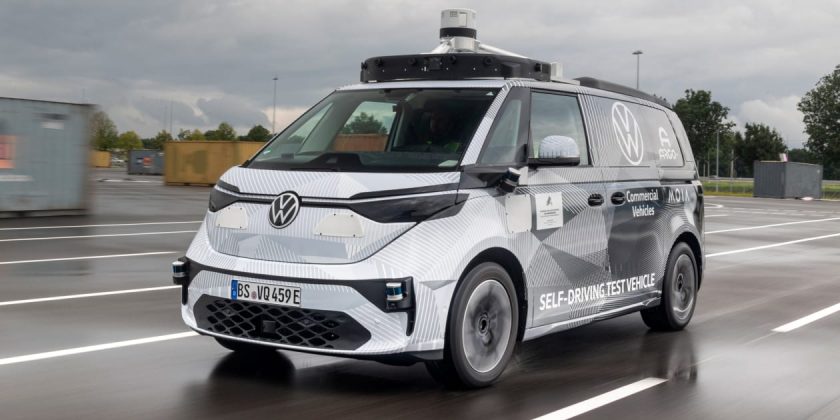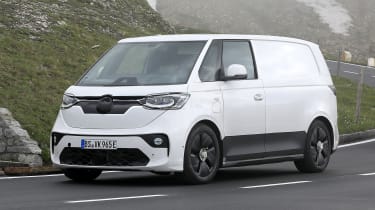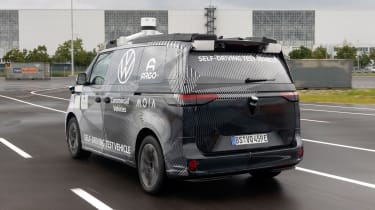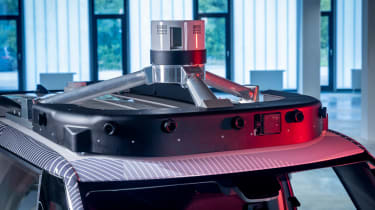Self-driving Volkswagen ID.Buzz electric van to be on German roads in 2025, under its new ride-hailing service, MOIA
Volkswagen has unveiled an autonomous ID.Buzz prototype at the Munich Motor Show, and revealed that it will soon enter service in Germany as part of the firm’s new ride-hailing business.
The self-driving electric van will run its first fare in 2025 under Volkswagen’s recently formed, Uber-rivalling mobility company, MOIA. Unlike its main rival, though, MOIA pools multiple fares into the same vehicle in an effort to use the road network more efficiently and ease inner-city congestion – hence the choice of the three-row ID.Buzz.
To make the ID.Buzz autonomous, Volkswagen called on the American technology company Argo AI. The firm started by fitting the EV with an arsenal of cameras, radar sensors and lidar sensors, which can detect objects from a distance of more than 400 metres.
New Volkswagen ID.2 to kick-start brand’s push into small electric cars
The hardware is backed up by some sophisticated software which Volkswagen says can predict the actions of pedestrians, cyclists and other vehicles. The brand also says the system will react naturally to any hazards, controlling the steering, throttle and brakes smoothly “like an experienced driver.”
The complexity of the self-driving system means that Volkswagen will only release the autonomous ID.Buzz in Hamburg to start, so it can control as many variables of the EV’s development as possible. However, the technology will be rolled out across more cities as the software improves.
Despite the challenge, Christain Senger, head of autonomous driving at Volkswagen Commercial Vehicles, is confident in the system’s capability. He said: “An environment recognition system from six lidar, 11 radar and 14 cameras, distributed over the entire vehicle, can capture much more than any human driver can from his seat.”
Volkswagen and Argo AI are currently developing the autonomous ID.Buzz at a nine-hectare facility near Munich airport. The site has been designed to simulate a range of traffic situations specific to European driving conditions.
Volkswagen ID.Buzz: platform and powertrain
Like the rest of Volkswagen’s ID-badged electric vehicles, the ID.Buzz is based on the MEB platform. Buyers will have a choice of either panel van or three-row passenger van variants, both of which will be available with batteries ranging in size from 48kWh to 111kWh. The larger unit will offer a maximum range of around 340 miles.
The van’s electric motors will be borrowed from the ID.3 hatchback and ID.4 SUV, with a 201bhp single-motor, rear-wheel-drive option sitting at the lower end of the line-up. However, a four wheel-drive, dual-motor model is also expected, producing a punchy 295bhp.
Volkswagen’s latest announcement also offers a closer look at the ID.Buzz’s styling, as most of the cladding has now been removed.
The company’s muse for the van’s design language was the iconic Type 2 Microbus of the 1950s, and the EV adopts the same upright windscreen and rounded panels. There are a couple of lumps in the roof, though, to house the various sensors and cameras.
Speaking at the 2017 Geneva Motor Show, Volkswagen’s then-design boss Oliver Stefani told Auto Express: “We would like to bring [the Microbus] back because it fits so well to what the brand stands for: it’s emotional, it has functionality, it makes your life easier.
“With the MEB platform this is the chance now to get the proportions back,” he added, referring to the fact that you don’t need to have an engine in the front with an EV. “But you can also get much more interior space, almost one class higher.”
Volkswagen ID.Buzz concept in detail
Volkswagen describes the ID. Buzz as a vehicle which “transfers a Microbus feeling into the future.” It draws inspiration from the Type 2 van, but the space-age interior, enormous 22-inch alloy wheels and wraparound LED headlamps pulls the design into the 21st Century.
Its styling certainly fits with the rest of Volkswagen’s ID. range – and, like its siblings, it’ll be based on the firm’s dedicated MEB electric underpinnings. The chassis will be stretched out to van-sized proportions, giving a 3.3-metre long wheelbase and short overhangs.
The wheel-at-each-corner design gives the ID. Buzz space for a flexible eight-seat cabin, with multi-adjustable rear chairs and a driver’s seat that swivels 180 degrees. The latter action happens automatically when the autonomous ID. Pilot mode is selected, retracting the single-piece capacitive touch steering wheel while the car takes full control of the driving.
Other tech includes an augmented reality head-up display and a removable portrait tablet that controls the car’s functions.
Just as in the concept, the batteries will act as a structural member in the floor of the production version, lowering the vehicle’s centre of gravity. Rear air suspension and adaptive dampers aim to deliver high levels of comfort, while a 10-metre turning circle is promised, thanks to rear-wheel steering.
Now read all the latest news on the upcoming Volkswagen ID.5 coupe-SUV…
Source: Read Full Article



 New Volkswagen ID.2 to kick-start brand’s push into small electric cars
New Volkswagen ID.2 to kick-start brand’s push into small electric cars
